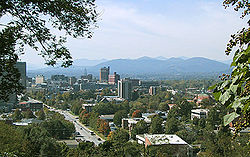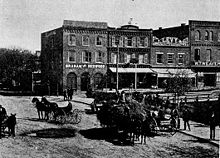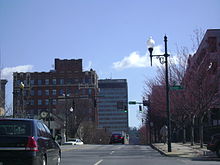- Asheville, North Carolina
-
Not to be confused with Ashville (disambiguation).
Asheville, North Carolina — City — Downtown Asheville 
Flag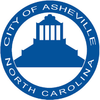
SealNickname(s): "Land of the Sky"[1] Location in North Carolina Coordinates: 35°34′48″N 82°33′21″W / 35.58°N 82.55583°WCoordinates: 35°34′48″N 82°33′21″W / 35.58°N 82.55583°W Country United States State North Carolina County Buncombe Incorporated 1797 Government – Mayor Terry Bellamy – Council Members Cecil Bothwell,
Jan Davis,
Esther Manheimer,
Brownie Newman,
Bill Russell,
Gordon SmithArea – City 41.3 sq mi (107.0 km2) – Land 40.9 sq mi (106.0 km2) – Water 0.4 sq mi (1.0 km2) 0.94% Elevation 2,134 ft (650 m) Population (2010)[2] – City 83,393. – Density 2,032.15/sq mi (786.02/km2) – Urban 238,318 – Metro 408,436 – Demonym Ashevillian US Census Bureau official Time zone Eastern (UTC-5) – Summer (DST) EDT (UTC-4) Area code(s) 828 FIPS code 37-02140[3] GNIS feature ID 1018864[4] Website www.ashevillenc.gov 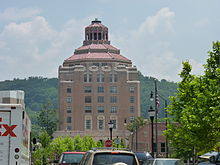 Asheville City Hall. Designed by Douglas Ellington, this building epitomizes the Art Deco style of the 1920s.
Asheville City Hall. Designed by Douglas Ellington, this building epitomizes the Art Deco style of the 1920s.
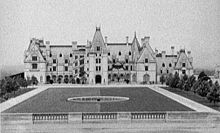 The Biltmore House on Biltmore Estate, which is the largest house in America, with more than 250 rooms, was built as a private residence complete with indoor pool and bowling alley. Modern guests, who also come to see the adjacent gardens, enjoy a similar view to this 1902 photo.
The Biltmore House on Biltmore Estate, which is the largest house in America, with more than 250 rooms, was built as a private residence complete with indoor pool and bowling alley. Modern guests, who also come to see the adjacent gardens, enjoy a similar view to this 1902 photo.
Asheville is a city in and the county seat of Buncombe County, North Carolina, United States.[5] It is the largest city in Western North Carolina, and the 11th largest city in North Carolina. The City is home to the United States National Climatic Data Center (NCDC), which is the world's largest active archive of weather data. The U.S. Census Bureau determined that Asheville's population in 2010 was 83,393.[2] Asheville is a part of the four-county Asheville Metropolitan Statistical Area, the population of which was estimated by the Census Bureau in 2010 to be 417,012.[6]
Contents
History
Origins
Before the arrival of Europeans, the land where Asheville now exists lay within the boundaries of the Cherokee Nation.[7] In 1540, Spanish explorer Hernando de Soto came to the area, bringing the first European visitors[8] in addition to European diseases which seriously depleted the native population.[9] The area was used as an open hunting ground until the middle of the 19th century.[10]
The history of Asheville, as a town, begins in 1784. In that year, Colonel Samuel Davidson and his family settled in the Swannanoa Valley, redeeming a soldier's land grant from the state of North Carolina. Soon after building a log cabin at the bank of Christian Creek, Davidson was lured into the woods by a band of Cherokee hunters and killed. Davidson's wife, child and female slave fled on foot to Davidson's Fort (named after Davidson's father General John Davidson) 16 miles away.
In response to the killing, Davidson's twin brother Major William Davidson and brother-in-law Colonel Daniel Smith formed an expedition to retrieve Samuel Davidson's body and avenge his murder. Months after the expedition, Major Davidson and other members of his extended family returned to the area and settled at the mouth of Bee Tree Creek.
The United States Census of 1790 counted 1,000 residents of the area, excluding the Cherokee Native Americans. Buncombe County was officially formed in 1792. The county seat, named “Morristown” in 1793, was established on a plateau where two old Indian trails crossed. In 1797, Morristown was incorporated and renamed “Asheville” after North Carolina Governor Samuel Ashe.[11][12]
The Civil War
Asheville, with a population of approximately 2,500 by 1861, remained relatively untouched by the Civil War, but contributed a number of companies to the Confederate States Army, and a substantially smaller number of soldiers to the Union.[citation needed] For a time, an Enfield rifle manufacturing facility was located in the town. The war came to Asheville as an afterthought, when the "Battle of Asheville" was fought in early April 1865 at the present-day site of the University of North Carolina at Asheville, with Union forces withdrawing to Tennessee after encountering resistance from a small group of Confederate senior and junior reserves and recuperating Confederate soldiers in prepared trench lines across the Buncombe Turnpike; orders had been given to the Union force to take Asheville only if this could be accomplished without significant losses.[citation needed]
An engagement was also fought later that month at Swannanoa Gap as part of the larger Stoneman's Raid, with Union forces retreating in the face of resistance from Brig. Gen. Martin, commander of Confederate troops in western North Carolina, but returning to the area via Howard's Gap and Henderson County.[citation needed] In late April 1865 troops under the overall command of Union Gen. Stoneman captured Asheville.[citation needed] After a negotiated departure, the troops nevertheless subsequently returned and plundered and burned a number of Confederate supporters' homes in the town.[citation needed] The years following the war were a time of economic and social hardship in Buncombe County, as throughout most of the defeated South.[citation needed]
1880s
On October 2, 1880, the Western North Carolina Railroad completed its line from Salisbury to Asheville, the first rail line to reach the city. Almost immediately it was sold and resold to the Richmond and Danville Railroad Company, becoming part of the Southern Railway in 1894.[13] With the completion of the first railway, Asheville experienced a slow but steady growth as industrial plants increased in number and size, and new residents built homes. Textile mills were established and plants were set up for the manufacture of wood and mica products, foodstuffs, and other commodities.[14]
The 21-mile distance between Hendersonville and Asheville of the former Asheville and Spartanburg Railroad was completed in 1886.[15] By that point, the line was operated as part of the Richmond and Danville Railroad until 1894 and controlled by the Southern Railway afterward.[16] (Asheville's final passenger train, a coach-only remnant of the Southern Railway's "Carolina Special", last runs on December 5, 1968.)
Asheville had the first electric street railway lines in the state of North Carolina, the first of which opened in 1889. These would be replaced by buses in 1934.[17]
1900s to present
 Construction on Grove Park Inn, 1912
Construction on Grove Park Inn, 1912
While Asheville prospered in the decades of 1910s and 1920s (at one point, Asheville was the 3rd largest city in North Carolina, behind Charlotte and Wilmington), the period of Asheville's history made world-famous by the novel Look Homeward, Angel, the Great Depression hit Asheville quite hard. On November 20, 1930, eight local banks failed.[18] Only Wachovia remained open with infusions of cash from Winston-Salem.[citation needed] Because of the explosive growth of the previous decades, the 'per capita' debt owed by the city (through municipal bonds) was the highest of any city in the nation.[19] By 1929, both city and Buncombe County had incurred over $56 million in bonded debt to pay for a wide range of municipal and infrastructure improvements, including the courthouse and City Hall, paved streets, Beaucatcher Tunnel, school buildings and municipal parks. Rather than default, the city paid those debts over a period of 50 years. From the start of the Depression through the 1980s, economic growth in Asheville was slow. During this time of financial stagnation, most of the buildings in the downtown district remained unaltered. This resulted in one of the most impressive, comprehensive collections of Art Deco architecture in the United States.[20][21]
The Asheville area was subject to severe flooding from the remnants of a tropical storm on July 15–16, 1916, causing over $3 million in damage. Heavy rains from the remnants of Hurricane Frances and Hurricane Ivan caused major flooding in Asheville in September 2004, particularly at Biltmore Village.{[9] [10]}
In 2003, Centennial Olympic Park bomber Eric Robert Rudolph was transported to Asheville from Murphy, North Carolina, for arraignment in federal court.[22][23]
Nationwide recognition
Asheville pops up on national rankings for a variety of things: Modern Maturity named it one of "The 50 Most Alive Places To Be,"[24] AmericanStyle magazine called it one of "America's Top 25 Arts Destinations,"[25] Self magazine labeled it the "Happiest City for Women,"[26] it is one of AARP Magazine's "Best Places to Reinvent Your Life",[27] and was proclaimed the "New Freak Capital of the U.S." by Rolling Stone. Asheville has also been called "a New Age Mecca" by CBS News' Eye On America,[28] In August 2006 Asheville was named one the "Best Outside Towns" by Outside Magazine.[29] In the 2008 book, The Geography of Bliss, by Eric Weiner, Asheville was cited by the author as one of the happiest places in the United States. In 2011 Asheville was picked as one of the “10 Most Beautiful Places in America” by Good Morning America.[30] In 2007, Asheville was named one of the top seven places to live in the U.S. by Frommer's Cities Ranked and Rated,[31] and #23 of 200 metro areas for business and careers by Forbes.[citation needed] It was also named one of the world's top 12 must-see destinations for 2007 by Frommer's travel guides.[32]
Asheville and the surrounding mountains are also popular in the autumn when fall foliage peaks in October. The scenic Blue Ridge Parkway runs through the area and near the Biltmore Estate.
Politics
Local government
The City of Asheville operates under a council-manager form of government, via its charter. Over 89 million American citizens live in this type of local government. City Council appoints a city manager to achieve the desired end set by the City Council. The manager oversees day-to-day city operations and executes Council established laws and policies. The city manager also ensures the entire community is being served. If the manager is not responsive to the governing body’s directions and guidance, the governing body has the authority to terminate the manager at any time. City Council also appoints the city attorney and the city clerk.[33] In the absence or disability of the mayor, the vice-mayor performs the mayoral duties. The vice-mayor is appointed by the members of City Council. City Council determines the needs to be addressed and the degree of service to be provided by the administrative branch of city government.
Mayor Terry Bellamy, the city's first African-American female mayor, is a member of the Mayors Against Illegal Guns Coalition.[34] In 2005, Mayor Charles Worley signed the U.S. Conference of Mayors Climate Protection Agreement, and in 2006 the City Council created the Sustainable Advisory Committee on Energy and the Environment. In 2007, the Council became the first city on the East Coast to commit to building all municipal buildings to LEED Gold Standards and to achieve 80% energy reduction of 2001 standards by 2040. In 2007, the Council signed an agreement with Warren Wilson College stating the intent of the city and college to work together toward climate partnership goals. In 2009, the election of city councilman Cecil Bothwell was challenged because the North Carolina Constitution does not allow for atheists to hold public office.[35]
- Current elected officials[36]
- Mayor: Terry Bellamy
- Vice-Mayor: Brownie Newman
- Council: Cecil Bothwell
- Council: Gordon Smith
- Council: Bill Russell
- Council: Esther Manheimer
- Council: Jan Davis
State government
In the North Carolina Senate, Martin Nesbitt (D-Asheville) and Tom Apodaca (R-Hendersonville) both represent parts of Buncombe county. Nesbitt represents most of the city of Asheville.[37] Apodaca a very small portion of the southern part of the city.[38]
In the North Carolina House of Representatives, Susan Fisher (D-Asheville), Patsy Keever (D-Asheville), and Tim Moffitt (R-Asheville) all represent parts of the county.[39] All three of them represent parts of the city.
Federal government
Obama won Asheville with about 70% of the vote, while he won the entire county of Buncombe with 56% of the vote. Obama has visited the city a few times and has said he loves Asheville and the State of North Carolina.[40] In April 2010, he and his family vacationed in the city; it was the first time he visited since October 5, 2008.[41]
The two U.S. Senators of North Carolina are Richard Burr (R-Winston Salem) and Kay Hagan (D-Greensboro). The city of Asheville is based in North Carolina's 11th congressional district, represented by U.S. Congressman Heath Shuler (D-Haywood County).
Geography
Asheville is located in the Blue Ridge Mountains at the confluence of the Swannanoa River and the French Broad River. According to the United States Census Bureau, the city has a total area of 41.3 square miles (107.0 km2), of which 40.9 square miles (105.9 km2) is land and 0.4 square miles (1.0 km2) (0.94%) is water.[citation needed]
Climate
The climate of Asheville is a humid subtropical climate (Koppen Cfa), resembling the rest of the southeastern U.S., but with noticeably cooler temperatures due to the higher altitude. The area's summers in particular, though warm, are not as hot as summers in cities farther east in the state, as average highs peak at 85 °F (29.4 °C) in July. Winters are cool, with a January mean of 36.4 °F (2.4 °C). Snowfall is sporadic and usually light, with an average seasonal amount of 13.3 inches (34 cm). Freezing rain often occurs, accompanied by more significant disruption. Precipitation is relatively well-spread, though fall and early winter are the driest, and totals 37.3 inches (947.4 mm).
Extremes range from -16 to 100 °F (-27 to 38 °C), in January 1985 and August 1983, respectively.[42][43]
Climate data for Asheville, North Carolina Month Jan Feb Mar Apr May Jun Jul Aug Sep Oct Nov Dec Year Average high °F (°C) 46.1
(7.8)50.3
(10.2)58.0
(14.4)66.8
(19.3)74.3
(23.5)80.8
(27.1)84.3
(29.1)82.9
(28.3)76.9
(24.9)67.7
(19.8)57.8
(14.3)49.6
(9.8)66.3 Average low °F (°C) 26.6
(−3.0)29.1
(−1.6)36.2
(2.3)43.8
(6.6)52.1
(11.2)59.6
(15.3)63.5
(17.5)62.4
(16.9)56.4
(13.6)45.0
(7.2)36.8
(2.7)29.8
(−1.2)45.1 Precipitation inches (mm) 3.07
(78)3.19
(81)3.89
(98.8)3.16
(80.3)3.53
(89.7)3.24
(82.3)2.97
(75.4)3.34
(84.8)3.01
(76.5)2.40
(61)2.93
(74.4)2.59
(65.8)37.32
(947.9)Snowfall inches (cm) 4.3
(10.9)3.1
(7.9)2.5
(6.4)0.8
(2)0
(0)0
(0)0
(0)0
(0)0
(0)0
(0)0.5
(1.3)2.1
(5.3)13.3
(33.8)Avg. precipitation days (≥ 0.01 in) 10.9 9.8 12.1 9.4 11.5 11.5 11.7 11.0 8.4 7.5 8.9 9.7 122.4 Avg. snowy days (≥ 0.1 in) 3.5 2.9 1.9 0.3 0 0 0 0 0 0 0.7 2.6 11.9 Sunshine hours 176.7 183.6 223.2 252.0 263.5 267.0 257.3 226.3 207.0 220.1 180.0 167.4 2,624.1 Source: NOAA (normals, 1971-2000),[44] HKO [45] Neighborhoods
- North - includes the neighborhoods of Albemarle Park, Beaverdam, Beaver Lake, Chestnut Hills, Colonial Heights, Grove Park, Kimberly, Montford, and Norwood Park. The Montford Area Historic District, Chestnut Hill Historic District, and Grove Park Historic District are listed in the National Register of Historic Places. Montford and Albemarle Park have been named local historic districts by the Asheville City Council.
- East - includes the neighborhoods of Beverly Hills, Chunn's Cove, Haw Creek, Oakley, Oteen, Reynolds, Riceville, and Town Mountain.
- West - includes the neighborhoods of Camelot, Wilshire Park, Bear Creek, Deaverview Park, Emma, Hi-Alta Park, Lucerne Park, Malvern Hills, Sulphur Springs, Haywood Road, and West Asheville.
- South - includes the neighborhoods of Ballantree, Biltmore Village, Biltmore Forest, Biltmore Park, Kenilworth, Oak Forest, Royal Pines, Shiloh, and Skyland. Biltmore Village has been named a local historic district by the Asheville City Council.[46]
Architecture
Notable architecture in Asheville includes its Art Deco city hall, and other unique buildings in the downtown area, such as the Battery Park Hotel, the Neo-Gothic Jackson Building, Grove Arcade and the Basilica of St. Lawrence. The S&W Cafeteria Building is also a fine example of Art Deco architecture in Asheville.[47] The Grove Park Inn is an important example of architecture and design of the Arts and Crafts movement.
Asheville's recovery from the Depression was slow and arduous. Because of the financial stagnation, there was little new construction and much of the downtown district remained unaltered. This however has allowed Asheville to be a great collection of Art Deco and truly a style all its own.
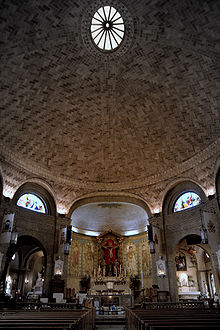 Inside dome of the Basilica of St. Lawrence, and final resting place of Rafael Guastavino (d. 1908) in Asheville.
Inside dome of the Basilica of St. Lawrence, and final resting place of Rafael Guastavino (d. 1908) in Asheville.
The Montford Area Historic District and other central areas are considered historic districts and include Victorian houses. On the other hand, Biltmore Village, located at the entrance to the famous estate, showcases unique architectural features that are found only in the Asheville area. It was here that workers stayed during the construction of George Vanderbilt's estate.[citation needed] Today, however, as with many of Asheville's historical districts, it has been transformed into a district home to quaint, trendy shops and interesting boutiques. The YMI Cultural Center, founded in 1892 by George Vanderbilt in the heart of downtown, is one of the nation's oldest African-American cultural centers.[48][49]
Demographics
Historical populations Census Pop. %± 1870 1,400 — 1880 2,616 86.9% 1890 10,235 291.2% 1900 14,694 43.6% 1910 18,762 27.7% 1920 28,504 51.9% 1930 50,193 76.1% 1940 51,310 2.2% 1950 53,000 3.3% 1960 60,192 13.6% 1970 57,929 −3.8% 1980 54,022 −6.7% 1990 61,607 14.0% 2000 68,889 11.8% 2010 83,393 21.1% Asheville is the larger principal city of the Asheville-Brevard CSA, a Combined Statistical Area that includes the Asheville metropolitan area (Buncombe, Haywood, Henderson, and Madison counties) and the Brevard micropolitan area (Transylvania County),[50][51][52] which had a combined population of 398,505 at the 2000 census.[3]
At the 2000 census[3], there were 68,889 people, 30,690 households and 16,726 families residing in the city. The population density was 1,683.4 per square mile (650.0/km²). There were 33,567 housing units at an average density of 820.3 per square mile (316.7/km²). The racial composition of the city was: 77.95% White, 17.61% Black or African American, 3.76% Hispanic or Latino American, 0.92% Asian American, 0.35% Native American, 0.06% Native Hawaiian or Other Pacific Islander, 1.53% some other race, and 1.58% two or more races.
There were 30,690 households of which 22.2% had children under the age of 18 living with them, 38.1% were married couples living together, 13.0% had a female householder with no husband present, and 45.5% were non-families. 36.8% of all households were made up of individuals and 13.8% had someone living alone who was 65 years of age or older. The average household size was 2.14 and the average family size was 2.81.
Age distribution was 19.6% under the age of 18, 10.3% from 18 to 24, 28.7% from 25 to 44, 23.1% from 45 to 64, and 18.3% who were 65 years of age or older. The median age was 39 years. For every 100 females there were 87.8 males. For every 100 females age 18 and over, there were 83.9 males.
The median household income was $32,772, and the median family income was $44,029. Males had a median income of $30,463 versus $23,488 for females. The per capita income for the city was $20,024. About 13% of families and 19% of the population were below the poverty line, including 24.9% of those under age 18 and 10.1% of those age 65 or over.
Metropolitan area
Asheville is the largest city located within the Asheville MSA (Metropolitan Statistical Area). The MSA includes Buncombe County; Haywood County; Henderson County; and Madison County; with a combined population - as of the 2008 Census Bureau population estimate - of 408,436.[6]
Apart from Asheville, the MSA includes Hendersonville and Waynesville, along with a number of smaller incorporated towns: Biltmore Forest, Black Mountain, Canton, Clyde, Flat Rock, Fletcher, Hot Springs, Laurel Park, Maggie Valley, Mars Hill, Marshall, Mills River, Montreat, Weaverville and Woodfin.
Several sizable unincorporated rural and suburban communities are also located nearby: Arden, Barnardsville (incorporated until 1970), Bent Creek, Candler, Enka, Fairview, Jupiter (incorporated until 1970), Leicester, Oteen, Skyland, and Swannanoa.
Economy
Largest employers
According to the city's 2009 Comprehensive Annual Financial Report,[53] the largest employers in the city are:
# Employer # of Employees 1 Mission Health System 3,000+ 2 Buncombe County Schools System 3,000+ 3 Ingles 3,000+ 4 State of North Carolina 1,000+ 5 Buncombe County 1,000+ 6 Asheville VA Medical Center 1,000+ 7 City of Asheville 1,000+ 8 Wal-Mart 1,000+ 9 The Biltmore Company 1,000+ 10 Asheville–Buncombe Technical Community College 1,000+ 11 Eaton 1,000+ 12 Grove Park Inn 500-999 13 Asheville City Schools 500-999 14 Community CarePartners 500-999 15 United States Postal Service 500-999 16 BorgWarner Turbo Systems 500-999 17 Thermo Fisher Scientific 500-999 18 arvato digital services 500-999 19 Employment Control 500-999 20 Volvo Construction Equipment 500-999 Education
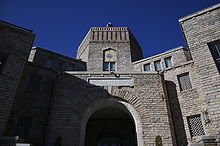 Asheville High School Main Entrance (designed by Douglas Ellington)
Asheville High School Main Entrance (designed by Douglas Ellington)
Public Asheville City Schools include Asheville High School (known as Lee H Edwards High School 1935-1969), School of Inquiry and Life Sciences at Asheville, Asheville Middle School, Claxton Elementary, Randolph Learning Center, Hall Fletcher Elementary, Isaac Dickson Elementary, Ira B. Jones Elementary and Vance Elementary. Asheville High has been ranked by Newsweek magazine as one of the top 100 high schools in the United States. The Buncombe County School System operates high schools, middle schools and elementary schools both inside and outside the city of Asheville. Clyde A. Erwin High School, T C Roberson High School and A. C. Reynolds High School are three Buncombe County schools located in Asheville.[citation needed]
Asheville was formerly home to one of the only Sudbury schools in the Southeast, Katuah Sudbury School. It is also home to several charter schools, including Francine Delany New School for Children (one of the first charter schools in North Carolina) and Evergreen Community Charter School, an Outward Bound-Expeditionary Learning School, recognized as one of the most environmentally conscious schools in the country.[54]
Two private residential high schools are located in the Asheville area: the all-male Christ School (located in Arden) and the co-educational Asheville School. Each offers a rigorous college preparatory curriculum and enrolls boarding students from around the world in addition to local day students. Several other private schools, including Rainbow Mountain Children's School, Asheville Christian Academy, Hanger Hall School for Girls, The New Classical Academy and Carolina Day School, enroll local day students.
Colleges
Asheville and its surrounding area have several institutions of higher education:
- Asheville-Buncombe Technical Community College (Asheville)
- Black Mountain College (Black Mountain: 1933-1957)
- Shaw University College of Adult and Professional Education or C.A.P.E.
- Brevard College (Brevard)
- Mars Hill College (Mars Hill)
- Montreat College (Montreat)
- University of North Carolina at Asheville (Asheville)
- Warren Wilson College (Swannanoa)
- Western Carolina University (Cullowhee)
- Blue Ridge Community College (Flat Rock)
Transportation
Asheville is served by Asheville Regional Airport in nearby Fletcher, North Carolina, and by Interstate 40, Interstate 240, and Interstate 26. A milestone was achieved in 2003 when Interstate 26 was extended from Mars Hill (north of Asheville) to Johnson City, Tennessee, completing a 20-year half-billion dollar construction project through the Blue Ridge Mountains. Work continues to improve Interstate 26 from Mars Hill to Interstate 40 by improving U.S. Route 19 and U.S. Route 23 and the western part of Interstate 240. This construction will include a multi-million dollar bridge to cross the French Broad River and is not slated to start until after 2008.[55]
The city operates the Asheville Transit System, which consists of several bus lines connecting parts of the city and surrounding areas.
The Norfolk Southern Railway passes through the city, though passenger service is currently not available in the area.
Public services and utilities
Water
Drinking water in Asheville is provided by the Asheville water department. The water system consists of three water treatment plants, more than 1,600 miles (2,600 km) of water lines, 30 pumping stations and 27 storage reservoirs. Until recently the direction of the water agency was shared between Buncombe County and the City of Asheville.[citation needed] The two governments are presently seeking agreement on water that could restore the previous intergovermental agency.[citation needed] The public drinking water supply in most areas of Asheville is presently fluoridated by the addition of hydrofluorosilic acid, at a rate of 0.9 to 1.1 parts per million[citation needed]
The original water system in Asheville dates from the 1880s when Asheville constructed a reservoir on Beaucatcher Mountain, collecting water from various springs and branches. Pipes were laid and unfiltered water distributed by gravity flowed down into the town.[citation needed]
Sewer
Sewer services are provided by the Metropolitan Sewerage District of Buncombe County.
Electricity
Power is provided by Progress Energy Inc.
Natural gas
Natural gas is provided by PSNC Energy.
Local culture
Music
Live music is a significant element in the tourism-based economy of Asheville and the surrounding area. Seasonal festivals and numerous nightclubs and performance venues offer opportunities for visitors and locals to attend a wide variety of live entertainment events.[56]
Asheville has a strong tradition of street performance, busking, and outdoor music, including festivals, such as Bele Chere and the Lexington Avenue Arts & Fun Festival (LAAFF). One event is "Shindig on the Green," which happens Saturday nights during July and August on City/County Plaza. By tradition, the Shindig starts "along about sundown" and features local bluegrass bands and dance teams on stage, and informal jam sessions under the trees surrounding the County Courthouse. Another popular outdoor music event is "Downtown After 5," a monthly concert series held from 5PM till 9PM that hosts popular touring musicians as well as local acts. An unorganized drum circle, held by residents in Pritchard Park and open to all, has been a popular local activity every Friday evening. [57]
Asheville annually plays host to the Warren Haynes Christmas Jam annually. The event raises money for Habitat For Humanity, and attracts major touring acts; past performers include Dave Matthews, The Allman Brothers, Ani Difranco, Widespread Panic, and Phish. Other big acts that have played the Asheville area in recent years are bands such as Porcupine Tree, Broken Social Scene, Ween, The Avett Brothers, Gillian Welch, Cat Power, Ghost Mice, Loretta Lynn, The Disco Biscuits, STS9, Pretty Lights, Primus, M. Ward and The Mountain Goats. DJ music, as well as a small, but active, dance community are also components of the downtown musical landscape. The town is also home to the Asheville Symphony and the Asheville Lyric Opera and there are a number of bluegrass, country, and traditional mountain musicians in the Asheville area. A residency at local music establishment The Orange Peel by Smashing Pumpkins in 2007, along with Beastie Boys in 2009, brought national attention to Asheville.[58] The Seattle based rock band, Band of Horses, have also recorded their last two albums at Echo Mountain Studios in Asheville, as have The Avett Brothers (who have also traditionally played a New Year's Eve concert in Asheville).
Award-winning Christian vocal group The Kingsmen originates in Asheville.
Sports
Current teams
Name Sport Founded League Venue Asheville Tourists Baseball 1897 South Atlantic McCormick Field Asheville Grizzlies Football ?? NAFL Memorial Stadium Previous teams
Name Sport Founded League Venue Years in Asheville Asheville Smoke Ice hockey 1991 United Hockey League Asheville Civic Center 1998 - 2002 Asheville Aces Ice hockey 2004 Southern Professional Hockey League Asheville Civic Center 2004 Asheville Altitude Basketball 2001 NBA Development League Asheville Civic Center 2001–2005 Other sports
Area colleges and universities, such as the University of North Carolina at Asheville, compete in sports. UNCA's sports teams are known as the Bulldogs and play in the Big South Conference. The Fighting Owls of Warren Wilson College participate in mountain biking and ultimate sports teams. The College is also home of the Hooter Dome, where the Owls play their home basketball games. The Civic Center is home to the Blue Ridge Rollergirls, an up and coming team in the sport of Women's Flat-Track Roller Derby.
Recreational sports
Asheville is a major hub of whitewater recreation, particularly whitewater kayaking, in the eastern US. Many kayak manufacturers have their bases of operation in the Asheville area.[59] Some of the most distinguished whitewater kayakers live in or around Asheville.[60] In its July/August 2006 journal, the group American Whitewater named Asheville one of the top five US whitewater cities.[60] Asheville is also home to numerous Disc Golf courses. Soccer is another popular recreational sport in Asheville. Many games are held at Azalea Park. HFC is the local soccer club in Asheville. The Asheville Hockey League provides opportunities for youth and adult inline hockey at an outdoor rink at Carrier Park. The rink is open to the public and pick-up hockey is also available. The Asheville Civic Center has held recreational ice hockey leagues in the past.
Performing arts
The Asheville Community Theatre was founded in 1946, producing the first amateur production of the Appalachian drama, Dark of the Moon. Soon after, the young actors Charlton Heston and wife Lydia Clarke would take over the small theatre. The current ACT building has two performance spaces - the Mainstage Auditorium, which seats 399 patrons (and named the Heston Auditorium for its most famous alumni); and the more intimate black box performance space 35 Below, seating 40 patrons.[citation needed]
The North Carolina Stage Company is the only resident professional theatre in the downtown area.
The Asheville Lyric Opera celebrated its 10th anniversary in 2009 with a concert featuring Angela Brown, David Malis, and Tonio Di Paolo, veterans of the Metropolitan Opera.[61] The ALO has typically performed three fully staged professional operas for the community in addition to its vibrant educational program.
Asheville Vaudeville,[62] Asheville's only monthly vaudeville variety show, performs new material each month from local magicians, jugglers, comedians, musicians, stilt-walkers, knife-throwers and more.[63]
In 2004, the Asheville Arts Center opened. It is a theatre, dance and music studio designed for arts education. The Grand Hall of the Arts Center is a regular venue for local bands as well as the Asheville Movement Collective.
The Asheville capoeira performance movement was solidified with the arrival of world renowned Mestre Pe de Chumbo Mestre Pe de Chumbo to the area in 2006. The capoeira group continues to give performances in the streets, on the stage and during festivals. Due to this group's cumulative efforts in the art of capoeira and in developing community[citation needed] the Asheville Culture Project (ACP) was established in 2010. The ACP is a community arts initiative that offers a space for the integration of cultural performing arts, community and social justice. The cultural center offers the community performances, classes and outreach.
In 2010 the Magnetic Theatre opened in the River Arts District and hosts performances of original works in a variety of genres.[64]
Places of worship
Places of worship in Asheville include the Roman Catholic Basilica of St. Lawrence, the Episcopal Cathedral of All Souls and St. Luke's Church, The Chabad House, and the Conservative Jewish Beth Israel Synagogue. Islamic Center of Asheville http://www.ashevillemasjid.com/
Film and television
Although the area has had a long history with the entertainment industry, recent developments are cementing Asheville as a potential growth area for both film and TV. The Asheville Film Festival has completed its sixth year. However the City of Asheville, which funds the festival, has announced that it will no longer fund the festival. The festival's future is in doubt. The city is also an annual participant in the 48-Hour Film Project.[citation needed] The city's Public-access television cable TV station URTV began broadcasting programs in spring 2006. Films made at least partially in the area include A Breed Apart, Searching for Angela Shelton, Last of the Mohicans, Being There, My Fellow Americans, Loggerheads, The Fugitive, All the Real Girls, Richie Rich, Thunder Road, Hannibal, Songcatcher, Patch Adams, Nell, Forrest Gump, Mr. Destiny, Dirty Dancing, Bull Durham, The Private Eyes, The Swan, The Clearing, House of Poets, The Purple Box, 28 Days "The Hunger Games". Locally produced films include Golden Throats of the 20th Century and Anywhere, USA, a winning film at the 2008 Sundance Film Festival.[citation needed]. And Asheville hosts the ActionFest Film Festival, the only festival in the world devoted to action film. The 2010 inaugural edition included Chuck Norris, who was honored as the first ActionFest "man of action."
Media
Asheville is in the "Greenville-Spartanburg-Asheville-Anderson" television DMA and the "Asheville" radio ADI for the city's radio stations.[65]
The primary television station in Asheville is ABC affiliate WLOS-TV Channel 13, with studios in Biltmore Park and a transmitter on Mount Pisgah. Other stations licensed to Asheville include WUNF, PBS station on Channel 33 and The CW affiliate WYCW on Channel 62. Asheville is also served by the Upstate South Carolina stations of WYFF Channel 4 (NBC), WSPA-TV Channel 7 (CBS), WHNS-TV Channel 21 (FOX), MyNetworkTV station WMYA Channel 40 and 3ABN station Channel 41. SCETV PBS affiliates from the Upstate of South Carolina are generally not carried on cable systems in the North Carolina portion of the DMA.
The Asheville Citizen-Times is Asheville's daily newspaper which covers most of Western North Carolina. The Mountain Xpress is the largest weekly in the area, covering arts and politics in the region.
Friends of Community Radio created Asheville FM, a volunteer-based, grassroots community radio station. It has been broadcasting since 2009 via the World Wide Web at www.AshevilleFM.org. The station is licensed under the "Free Form" format. There are also a variety of broadcasts dedicated to Poetry, Interviews, Selected Topics, Children's Radio, and Comedy. The staff have remote broad-casted many local concerts including (but not limited too) Monotonix from Israel, JEFF the Brotherhood from Nashville, Screaming Females from New Jersey, and local acts.
Notable people
Living
- Harry Anderson (1952- ), starred in 9 seasons of NBC's "Night Court."[66]
- John Avery (1976- ), football player in the NFL, XFL, and CFL, attended Asheville High School[67]
- Crezdon Butler (1987- ), National Football League corner back for the Pittsburgh Steelers, born and raised in Asheville, led Asheville High School to 2006 state championship.[68]
- Greg Cartwright (1970- ), rock musician, relocated to Asheville[69]
- Adam Copeland (1973- ), retired professional wrestler, author, relocated to Asheville
- Brad Daugherty (1965- ), retired NBA basketball player and current ESPN NASCAR analyst[70]
- Jim Eason (1935-), Radio talk show host
- John Ehle (1925-), author
- Sallie Ford of Sallie Ford and the Sound Outside, singer[71]
- Charles Frazier (1950- ), author, born in Asheville and graduated from University of North Carolina at Chapel Hill[72]
- Roberta Flack (1937- ), singer, born in Asheville[73]
- Eileen Fulton (1933- ), actress, born in Asheville, has starred on the CBS soap As the World Turns since 1960[74]
- Gail Godwin (1938- ), novelist, spent her early years in Asheville with her mother Kathleen Krahenbuhl Cole
- Joel Goffin (1981 - ), Motion Picture Composer, Music Producer
- Warren Haynes (1960- ), musician, spent his formative years in Asheville[75]
- Darren Holmes (1966-), MLB player for the Los Angeles Dodgers, Milwaukee Brewers, Colorado Rockies, New York Yankees, Arizona Diamondbacks, St. Louis Cardinals, Baltimore Orioles, and the Atlanta Braves
- David Holt (1946- ), American folk musician, currently residing near Asheville[76]
- Gary Jules (1969- ), American Singer-Songwriter, best known for his rendition of 'Mad World' for the film Donnie Darko.
- Loyd King (1949- ), retired professional basketball player
- Hope Larson (1982- ), Eisner award-winning American illustrator/cartoonist and author of graphic novels Salamander Dream and Chiggers.[77]
- Leonard Little (1974- ), NFL football player with the St. Louis Rams, born and raised in Asheville[78]
- Andie MacDowell (1958- ), actress, lives in Biltmore Forest, adjacent to Asheville[79]
- Cameron Maybin (1987- ), major league baseball player with the San Diego Padres, born and raised in Asheville[80]
- Rashad McCants (1984-), Former NBA basketball player for the Minnesota Timberwolves and Sacramento Kings and former Erwin High School basketball player[81]
- Bryan Lee O'Malley (1976- ), award-winning Canadian cartoonist and creator of the Scott Pilgrim graphic novel series.[82]
- Buzz Peterson (1963- ), formerly director of player personnel for the Charlotte Bobcats and now men's head basketball coach at UNC Wilmington,[83] born and raised in Asheville[84]
- Robert Pressley (1959- ), retired NASCAR driver, born in Asheville[85]
- Paul Schneider (1976-), Actor
- Angela Shelton (1972- ), actress and producer[86]
- Brett Swain (1986-), NFL player for the Green Bay Packers
- Hannah McIalwain, contestant on The Glee Project.
- Roy Williams (1950- ), University of North Carolina at Chapel Hill basketball coach, raised in Asheville[87]
- William Winkenwerder, Jr., Assistant Secretary of Defense for Health Affairs (2001–2007)[88]
Deceased
- Donald V. Bennett (1915–2005), former commanding general of the US Army Pacific Command.
- Elizabeth Blackwell (1821–1910), first recognized woman doctor in the United States
- Joe Bowman (1925–2009), bootmaker and marksman of American West entertainment grew up in Asheville but left for Houston, Texas, in 1937
- William Jennings Bryan (1860–1925), 20th century politician, presidential candidate[89]
- Douglas Ellington (1886–1960), architect, designer of Asheville City Hall, Asheville High School
- Zelda Fitzgerald (1900–1948), wife of F. Scott Fitzgerald, died in a fire with 8 other women at Highland Hospital, an Asheville mental institution in the Montford district.
- Edwin Wiley Grove (1850–1927), patent medicine inventor, builder and owner of the Grove Park Inn
- Rafael Guastavino (1842–1908), architect, final resting place at the Basilica of St. Lawrence, Asheville
- Dorothy Hart (1922–2004), Screen actress, known mostly for her supporting roles.
- William S. Hart (1864–1946), famous cowboy actor in early Hollywood, resided in Asheville around 1900 and coached shows at the Asheville Opera House.[90]
- Shirley Hemphill (1947–1999), stand-up comedian and actress, best known for What's Happening!!, 1976–79
- Charlton Heston (1923–2008), Oscar-winning actor, managed the Asheville Community Theatre with his wife Lydia in 1947
- Hughie Jennings (1869–1968), Major League Baseball player and manager from 1891 to 1925.
- Charlie "Choo Choo" Justice (1924–2003), professional football player
- Bascom Lamar Lunsford (1882–1973), folklorist, musician, folk festival founder
- Robert Moog (1934–2005), pioneer of electronic music, inventor of the Moog synthesizer
- Robert Morgan (1918–2004), pilot of the "Memphis Belle", the famed WWII B-17 bomber
- Doan Ogden (1908–1989), nationally noted landscape architect during the 20th century.
- Kenneth Noland (1924–2010), Abstract painter, he was one of the best-known American Color Field painters
- William Sydney Porter "O. Henry" (1862–1910), author
- Marjorie Rambeau (1889–1970), Hollywood actress, was married to Francis A. Gudger, a resident of Asheville, and resided in Asheville in the winter from 1932 to the mid 1940s.[91]
- Kiffin Rockwell (1892–1916), aviator, pilot in the Lafayette Escadrille, first American to shoot down an enemy aircraft
- Root Boy Slim aka Foster Mackenzie III (1945–1993), blues musician
- Don Thompson (1923–2009), Major League Baseball player for the Brooklyn Dodgers
- George Washington Vanderbilt II (1862–1914), entrepreneur, founder of the Biltmore Estate
- Thomas Wolfe (1900–1938), author
Points of interest
- Biltmore Estate
- Blue Ridge Parkway
- Botanical Gardens at Asheville
- Grove Park Inn
- North Carolina Arboretum
- Smith-McDowell House
- Sliding Rock
- Bent Creek
- Great Smoky Mountains National Park
- McCormick Field
- National Climatic Data Center (NCDC)
- Thomas Wolfe Memorial State Historic Site
Sister cities
Asheville has six sister cities:[92]
 Karpenisi (Greece)
Karpenisi (Greece) San Cristóbal de las Casas (Mexico)
San Cristóbal de las Casas (Mexico) Saumur (France)
Saumur (France) Valladolid, Yucatán (Mexico)
Valladolid, Yucatán (Mexico) Vladikavkaz (Russia)
Vladikavkaz (Russia) Osogbo, (Nigeria)
Osogbo, (Nigeria)
References
- ^ "Why Work for BCS?". BCS website.. Buncombe County Schools. http://www.buncombe.k12.nc.us/domain/28. Retrieved 3 November 2011.
- ^ a b Population Finder: Asheville, North Carolina. U.S. Census Bureau, 2006 Population Estimates. Accessed February 10, 2007.
- ^ a b c "American FactFinder". United States Census Bureau. http://factfinder.census.gov. Retrieved 2008-01-31.
- ^ "US Board on Geographic Names". United States Geological Survey. 2007-10-25. http://geonames.usgs.gov. Retrieved 2008-01-31.
- ^ "Find a County". National Association of Counties. http://www.naco.org/Counties/Pages/FindACounty.aspx. Retrieved 2011-06-07.
- ^ a b "Census Bureau Home Page". http://www.census.gov/.
- ^ "Original extent of Cherokee claims 1732" (map/.GIF). Collection at the University of Georgia. 1996-06-26. Archived from the original on 2006-06-26. http://web.archive.org/web/20060626113310/http://cherokeehistory.com/original.gif. Retrieved 2006-07-23.
- ^ The Historic News (1999). "A History of Asheville and Buncombe County" (text/.html). Old Buncombe County Genealogical Society. http://www.obcgs.com/ashv_hist.htm. Retrieved 2006-07-23.
- ^ "Cherokee History, Part One" (text/.html). Lee Sultzman. 1996-02-28. http://www.tolatsga.org/Cherokee1.html. Retrieved 2006-07-23.
- ^ "Asheville - 0-1800 The Early Settlers" (text/.html). Asheville.be. 2006. http://www.asheville.be/history/Asheville_History_Pre_1800.html. Retrieved 2006-07-23.
- ^ Caton, Alex S.; Rebecca Lamb (1999-2004). "The Early Settlement of Buncombe Country and the Drover's Road" (text/.html). Smith-McDowell House Museum. Archived from the original on 2006-07-20. http://web.archive.org/web/20060720052153/http://www.wnchistory.org/museum/droversroad.htm. Retrieved 2006-07-23.
- ^ "Western North Carolina Heritage: Asheville" (text/.htm). Land of the Sky. 2001-2002. http://dd1.library.appstate.edu/regional_history/urban%20centers/asheville.htm. Retrieved 2006-07-23.
- ^ http://www.historync.org/railroad-WNCRR.htm
- ^ The Federal Writers' Project of the Federal Works Agency, Works Projects Administration for the State of North Carolina, "North Carolina: A Guide to the Old North State", The University of North Carolina Press, Chapel Hill, 1939, page 139.
- ^ Thomas Lanier Clingman: Fire Eater from the Carolina Mountains, Thomas E. Jeffrey, page 213
- ^ Appalachian History: Manuscript Resources in Special Collections, Asheville and Spartanburg Railroad Company
- ^ The Federal Writers' Project of the Federal Works Agency, Works Projects Administration for the State of North Carolina, "North Carolina: A Guide to the Old North State", The University of North Carolina Press, Chapel Hill, 1939, pages 69, 139.
- ^ "8 CAROLINA BANKS FAIL AS BOOM ENDS". The New York Times. 1930-11-21. http://select.nytimes.com/gst/abstract.html?res=F60912F7355C11738DDDA80A94D9415B808FF1D3. Retrieved 2010-04-25.
- ^ http://www.nps.gov/nr/travel/asheville/preservation.htm
- ^ ABOUT
- ^ Preservation-Asheville, North Carolina: A National Register of Historic Places Travel Itinerary
- ^ Ellingwood, Ken (2003-06-02). "The Nation; Fugitive's Capture Heightens Speculation; Locals are touchy about the theory that some sympathetic with his anti- government views helped the suspected bomber elude the law". http://pqasb.pqarchiver.com/latimes/access/342886211.html?dids=342886211:342886211&FMT=ABS.
- ^ Fletcher, Michael A (2003-06-03). "Rudolph to be tried first in Alabama ; Abortion clinic bomb case said to be strongest". Chicago Tribune. http://pqasb.pqarchiver.com/chicagotribune/access/343027361.html?dids=343027361:343027361&FMT=ABS.
- ^ Modern Maturity. May–June 2000,
- ^ AmericanStyle Magazine, Summer 2001, 2002, 2003 & 2004.
- ^ Self, October 2002.
- ^ "Best Places to Reinvent Your Life", AARP Magazine, May–June 2003
- ^ CBS News' Eye On America, 1996. [1].
- ^ Outside Magazine Best Outside Town Archive
- ^ [2],
- ^ "24 Blue Ridge Mountain Retirement Locations". Retirement Housing Guide. http://www.e50plus.com/public/937.cfm. Retrieved 2009-05-15.
- ^ Frommer's, November 2007, [3].
- ^ http://www.ashevillenc.gov/Government/AboutCityGovernment.aspx
- ^ "Mayors Against Illegal Guns: Coalition Members". http://www.mayorsagainstillegalguns.org/html/about/members.shtml.
- ^ Schrader, Jordan; Neal, Dale (December 8, 2009). "Critics of Cecil Bothwell cite N.C. bar to atheists". Asheville Citizen-Times. Archived from the original on December 10, 2009. http://www.freezepage.com/1260466905IMUDOBICGE. Retrieved December 10, 2009.
- ^ http://www.ashevillenc.gov/CityCouncil/MeetCityCouncil.aspx
- ^ http://www.ourcampaigns.com/ContainerDetail.html?ContainerID=12069
- ^ http://www.ourcampaigns.com/ContainerDetail.html?ContainerID=12068
- ^ http://www.ncleg.net/gascripts/counties/counties.pl?county=Buncombe
- ^ http://www.npr.org/blogs/itsallpolitics/2011/10/17/141415067/obama-hearts-north-carolina-but-it-may-have-lost-that-loving-feeling
- ^ http://www.huffingtonpost.com/2010/04/16/obama-vacation-first-fami_n_541131.html
- ^ NOAA records for August - Asheville, NC
- ^ NOAA records for January - Asheville, NC
- ^ "Climatography of the United States No. 20 (1971–2000)" (PDF). National Oceanic and Atmospheric Administration. June 2011. http://cdo.ncdc.noaa.gov/climatenormals/clim20/nc/310301.pdf. Retrieved 2010-05-31.
- ^ "Climatological Normals of Asheville". Hong Kong Observatory. http://www.weather.gov.hk/wxinfo/climat/world/eng/n_america/us/Asheville_e.htm. Retrieved 2010-05-31.
- ^ http://www.ashevilleneighborhoods.info/ Asheville Neighborhoods.info listing of Asheville neighborhoods
- ^ http://www.heritagewnc.org/buildings/s&w_cafeteria.htm WNC Heritage Database
- ^ Putting YMI on the Map: The YMI Cultural Center History Project
- ^ History of the YMI
- ^ METROPOLITAN STATISTICAL AREAS AND COMPONENTS, Office of Management and Budget, 2007-05-11. Accessed 2008-08-01.
- ^ MICROPOLITAN STATISTICAL AREAS AND COMPONENTS, Office of Management and Budget, 2007-05-11. Accessed 2008-08-01.
- ^ COMBINED STATISTICAL AREAS AND COMPONENT CORE BASED STATISTICAL AREAS, Office of Management and Budget, 2007-05-11. Accessed 2008-08-01.
- ^ "City of Asheville Comprehensive Annual Financial Report" (PDF). http://www.ashevillenc.gov/uploadedFiles/Departments/Finance/15-CAFR%20Statistical%20section%202008-09.pdf.
- ^ http://www.evergreenccs.org/
- ^ "I-26 Connector, Asheville, NC". Public Information Website. North Carolina Department of Transportation. undated. http://www.ncdot.org/projects/I26Connector/default.html. Retrieved 2006-08-20.
- ^ "Music pumps up economy, enlivens nightlife"; Michael Flynn; Asheville Citizen-Times; August 22, 2003
- ^ Dewan, Shaila (Oct 24 2010). "36 Hours in Asheville". New York Times. http://mobile.nytimes.com/article?a=684577. Retrieved 6 June 2011.
- ^ "Smashing Pumpkins' return puts Asheville on music map"; Associated Press; June 22, 2007 http://www.ledger-dispatch.com/life/lifeview.asp?c=217801
- ^ Rocking the boat | Mountain Xpress Features | mountainx.com
- ^ a b American Whitewater Journal July/August 2006 (not published on the web yet)
- ^ Asheville Citizen-Times article on Asheville Lyric Opera's Tenth Anniversary. Jan 26, 2009. Accessed February 2, 2009
- ^ [4]
- ^ Vaudeville! Burlesque! Cabaret!
- ^ In Asheville, N.C., the River Arts District Blooms. Dec 1, 2010. Accessed June 4, 2011
- ^ Market Ranks and Schedule (1-50)
- ^ New York Times - For Harry Anderson, the New Orleans Magic Is Gone; August 30, 2006
- ^ CFL Roster;
- ^ http://www.nfl.com/players/profile?id=BUT133826
- ^ "Despite personal tensions and lineup changes, labelmates Lost Sounds and the Reigning Sound push ahead."; [5]
- ^ "Racer at heart, Daugherty much more than meets eye";
- ^ Ryan White (January 07, 2010). "Sallie Ford and the Sound Outside build some buzz". The Oregonian. http://www.oregonlive.com/music/index.ssf/2010/01/sallie_ford_and_the_sound_outs.html. Retrieved 2011-04-27.
- ^ [6]
- ^ Roberta Flack Biography;
- ^ Eileen Fulton Biography;
- ^ Mule.net Meet the Band;
- ^ David Holt: About David;
- ^ Zack Smith. "Hope Larson on Chiggers and More". Newsarama. http://forum.newsarama.com/showthread.php?t=153858. Retrieved April 18, 2008.
- ^ Leonard Little
- ^ "The two lives of Andie MacDowell";
- ^ "Keep an Eye on Roberson High School’s Cameron Maybin ";
- ^ NBADraft.net - Rashad McCants profile
- ^ Bryan Lee O'Malley|LibraryThing;
- ^ http://sports.espn.go.com/ncb/news/story?id=5102100
- ^ buzzhired
- ^ Robert Pressley
- ^ Angela Shelton (I) - Biography
- ^ asheville.com news: Roy Williams
- ^ http://bulk.resource.org/gpo.gov/record/2001/2001_E02167.pdf Representative Charles H. Taylor - United States Congress - Congressional Record, Thursday, November 29, 2001
- ^ http://www.heritagewnc.org/historic_register_sites/default_national_register.htm National Historic Sites of Asheville, Buncombe County
- ^ [7]
- ^ [8] Asheville Citizen-Times w/ photo
- ^ "Asheville Sister Cities." Asheville Sister Cities Inc. Retrieved on July 8, 2008.
- "24 Blue Ridge Mountain Retirement Locations". Retirement Housing Guide. http://www.e50plus.com/public/937.cfm. Retrieved 2009-05-15.
External links
- Official Asheville, NC website
- Official Buncombe County, NC website
- Asheville, North Carolina, a National Park Service Discover Our Shared Heritage Travel Itinerary
- The Battle of Asheville
- mapAsheville, City of Asheville web-mapping and search tools
- Asheville travel guide from Wikitravel
- A Weekend in Asheville, N.C. - slideshow by The New York Times
Municipalities and communities of Buncombe County, North Carolina County seat: AshevilleCity Asheville
Towns CDPs Avery Creek | Bent Creek | Fairview | Leicester | Royal Pines | Swannanoa
Unincorporated
communitiesArden | Barnardsville | Candler | Enka | Jupiter | Ridgecrest | Skyland
University of North Carolina at Asheville (UNC Asheville) Asheville, North Carolina • Botanical Gardens • Big South Conference • Bulldogs • Justice Center • Kimmel Arena • University of North Carolina
All-America City Award: Hall of Fame Akron, Ohio • Anchorage, Alaska • Asheville, North Carolina • Baltimore, Maryland • Boston, Massachusetts • Cincinnati, Ohio • Cleveland, Ohio • Columbus, Ohio • Dayton, Ohio • Des Moines, Iowa • Edinburg, Texas • Fort Wayne, Indiana • Grand Island, Nebraska • Grand Rapids, Michigan • Hickory, North Carolina • Independence, Missouri • Kansas City, Missouri • Laurinburg, North Carolina • New Haven, Connecticut • Peoria, Illinois • Philadelphia, Pennsylvania • Phoenix, Arizona • Roanoke, Virginia • Rockville, Maryland • Saint Paul, Minnesota • San Antonio, Texas • Seward, Alaska • Shreveport, Louisiana • Tacoma, Washington • Toledo, Ohio • Tupelo, Mississippi • Wichita, Kansas • Worcester, Massachusetts
Categories:- Asheville, North Carolina
- Cities in North Carolina
- County seats in North Carolina
- Populated places established in 1784
- Asheville metropolitan area
Wikimedia Foundation. 2010.

